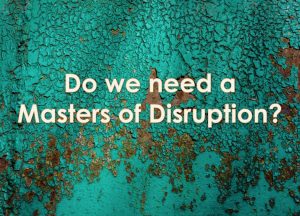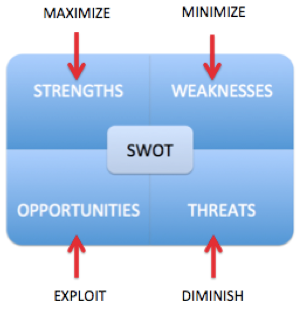by Charles Plant | Jun 13, 2016 | Management Training
 The comments from my last blog got me thinking about MBA programs in general and Masters in Innovation programs in particular.
The comments from my last blog got me thinking about MBA programs in general and Masters in Innovation programs in particular.
The businesses that are succeeding today (and by succeeding I mean are having huge growth in acceptance, revenue, valuation, etc.) are the ones that are disrupting the status quo in novel ways. So if these are today’s successful businesses, where can students go to learn these new ways of thinking, the new skills and the new business paradigms that create successful disruptors?
MBA programs are good at teaching people how to analyze everything that moves, preserve the status quo, and avoid risk. But they don’t do a very good job of teaching students to think outside the box. There may be courses within an MBA on disruption but I haven’t found one.
I thought that perhaps there might be Masters of Innovation programs that teach disruption in general but my quick review of these programs is that they seem to favour continuous innovation and fitting in to corporate norms. I’m still searching for a program in disruption but not having much success.
There are disruptive ideas in every part of a business. They crop up in human resources through the adoption of Holocracy. They create new means of financing such as crowd funding. They disrupt supply chains as Amazon has done. They change the face of marketing through social media. I could go on and on with how every facet of our lives is being disrupted but I think you get the point.
We are living through a time of massive disruption and yet I can’t find anyone focussing on disruption in a business program. I think we need to remedy this. We need to create a Masters of Disruption.
We could cover basic business topics in such a Masters but focus on how the world of business is being disrupted right now. Even more, we could challenge students to become disruptors themselves, to find new ways to alter the status quo.
I suppose we can’t call it a Masters if Disruption as I don’t think that would fly very well at an interview. (Can you see your typical HR manager actually want to hire a disruptor?) But we could easily focus on just such a topic through series of courses on innovation.
But to actually create just such a program I suspect that we need a disruption in business education. And how we do that is leaving me stumped.
by Charles Plant | Apr 1, 2013 | Management Training
 You may have celebrated April Fool’s Day your whole life but did you know that it was originally in March and officially proclaimed to be on April 1st by King Richard the 2nd of England?
You may have celebrated April Fool’s Day your whole life but did you know that it was originally in March and officially proclaimed to be on April 1st by King Richard the 2nd of England?
Bear with me here. King Richard had a court clerk by the name of Chauntecleer, a student of Roman history. He was particularly fond of the Roman festival of Hilaria which was celebrated on the eighth day after the vernal equinox. Geoffrey Chaucer mentions this celebration in his Canterbury Tales as being on the 32nd day of March.
Back to Richard. While Richard was not insane, he did have some particularly nasty character flaws, one of which was playing tricks on the peasants. Towards the end of one abnormally long peasant revolt in the winter of 1392, he declared that all of the peasant’s demands would be met and feeling satisfied, they all went home.
Eight days later, invoking the ancient feast of Hilaria, Richard rescinded his edict and declared the peasants to be fools and that the 32nd day of March would forever be known as April Fool’s Day in their honour.
by Charles Plant | Mar 14, 2013 | Learning

I thought of using the term Brain Plasticity in the title to this blog but since I didn’t understand the term I figured ‘Use it or Lose it’ would be a better way to go. But then that’s the point isn’t it? If you want to retain something you’ve learned, you have to use it on a regular basis. It’s the way your brain works.
Some 20 years ago, researchers found that with the right stimulus, brain deterioration and ageing was in fact reversible. The brain actually changes as you improve an ability. The local wiring changes how its connected and those changes result in the acquisition of an ability. The brain evolves as you acquire an ability.
It’s the reason that the Seven Times Principle works. So if you want to learn something:
- Write it down
- Repeat it seven times
- Make sure you’re tested on it.
- Use it or lose it.
by Charles Plant | Mar 13, 2013 | Learning
 Did you ever wonder why your teachers told you to study early and often for a test? Well it turns out that there may be something to it. You’re actually better off distributing your practise on anything rather than trying to learn something by cramming.
Did you ever wonder why your teachers told you to study early and often for a test? Well it turns out that there may be something to it. You’re actually better off distributing your practise on anything rather than trying to learn something by cramming.
The problem is that it is easier to teach things in a group and not in a distributed pattern.It’s also more convenient although not better to learn that way. That’s why leadership and other improvement courses are all put in a day or a closely packed series of days, rather than over a longer period.
But studies by such researchers as Ebbinghaus and Dempster have been showing over the last century that distributed practise leads to more durable learning. I guess it comes back to the Seven Times Principle. You need to hear or try something seven times before it sticks.
If you’re trying to train someone on anything it will also work. You’ll have to get them to try it seven times before it will stick.
by Charles Plant | Mar 11, 2013 | Learning
 Do you remember the one person in the class who, when presented with something a little out of the ordinary, would ask the prof: will this be on the test?
Do you remember the one person in the class who, when presented with something a little out of the ordinary, would ask the prof: will this be on the test?
Think now to the answer. If it was not going to be on the test, would you bother learning it or even bother reviewing the material once? I didn’t think so.
Now think about your company’s values. Can you even remember what they are. Heaven knows, some group of executives spent a long time coming up with them. But do they form part of your annual performance appraisal? Are you judged on how well you exhibit those values, how close you are to achieving them?
Chances are you aren’t evaluated on such things as how you exemplify the company’s values and that’s a problem. If it won’t be on the test, you won’t even think twice about it.
If you want someone to learn something and to change their behaviour, they have to think they’ll be evaluated on it or chances are it will go in one ear and out the other.
by Charles Plant | Oct 11, 2012 | Management
Developing a strategy for a business is very simple when you use SWOT and combine it with the concepts of Quality, Cost and Speed.
The first step is to figure out your Strengths, Weaknesses, Opportunities and Threats for each of the three dimensions of Quality, Cost and Speed. For example:
- In terms of quality you may have a greater reliability than your competitor but less product choice. There may also be a new entrant to the market with newer technology going after a new market segment. Each of these is an element of SWOT.
- In terms of cost, you may have a more expensive product that is threatened by newer methods of production which could serve to make your competitor cheaper.
- Finally, for speed, you may have slower delivery times due to a slower manufacturing cycle time.
Figuring out strategy from SWOT would then have you do the following:

Very simply to develop strategy, you would maximize strengths, exploit opportunities, minimize weaknesses, and get rid of threats. In our simple example you might want to:
- Put in a new assembly line to lower costs of production and increase speed of delivery.
- Use the newer technology on that assembly line both to exploit new markets and broaden your product offering.
The hard part isn’t developing a strategy to beat the competition, it is figuring out what the problem really is in the first place.
 The comments from my last blog got me thinking about MBA programs in general and Masters in Innovation programs in particular.
The comments from my last blog got me thinking about MBA programs in general and Masters in Innovation programs in particular.




